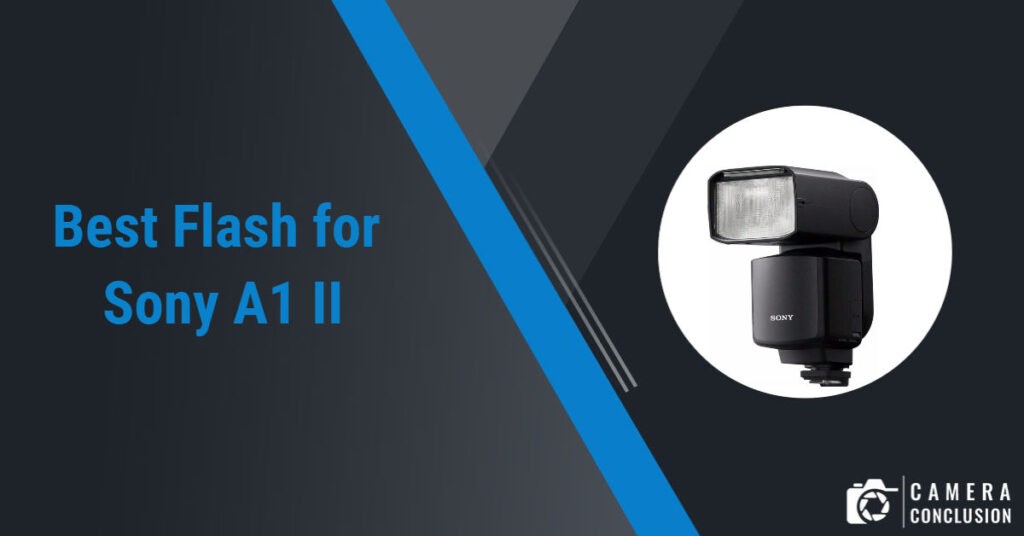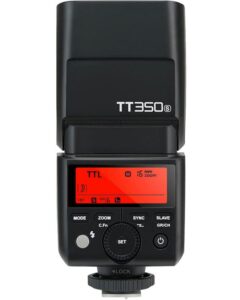Index
The Sony A1 II Flash represents a pinnacle of lighting innovation, tailored for photographers who demand speed, precision, and uncompromising power.
Whether you’re shooting high-speed sports, weddings, wildlife, or studio portraits, this flash unit delivers exceptional performance with lightning-fast recycling times, impressive guide numbers, and versatile control options.
Designed to seamlessly integrate with Sony’s mirrorless system, the A1 II Flash offers full TTL compatibility, intuitive wireless triggering, and adjustable beam patterns—giving you the freedom to shape light exactly the way you envision it.
Built rugged yet lightweight, it keeps up with the intensity of professional use without weighing you down.
With the Sony A1 II Flash, you’re getting more than just illumination—you’re investing in a lighting tool that elevates your vision, ensures consistency in challenging conditions, and opens creative possibilities that other flashes simply can’t match.
Best Flash for Sony A1 II: Top Picks for Pro-Level Lighting
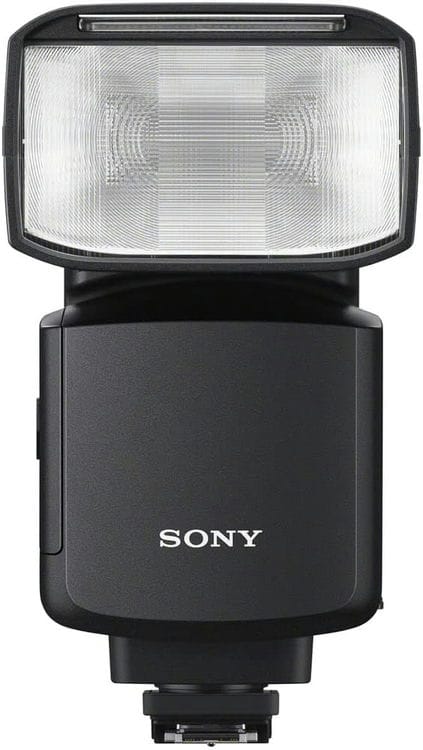 |
(Editor’s Choice) |
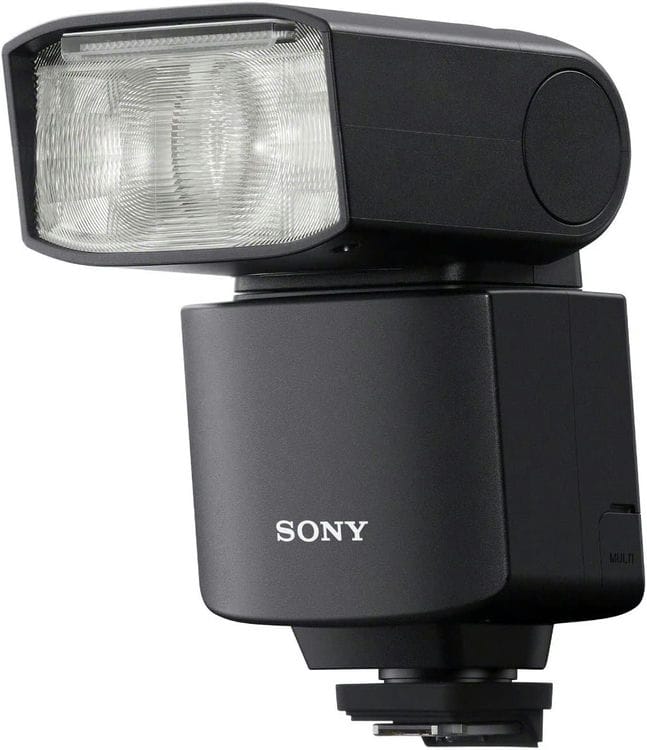 |
(Editor’s Choice) |
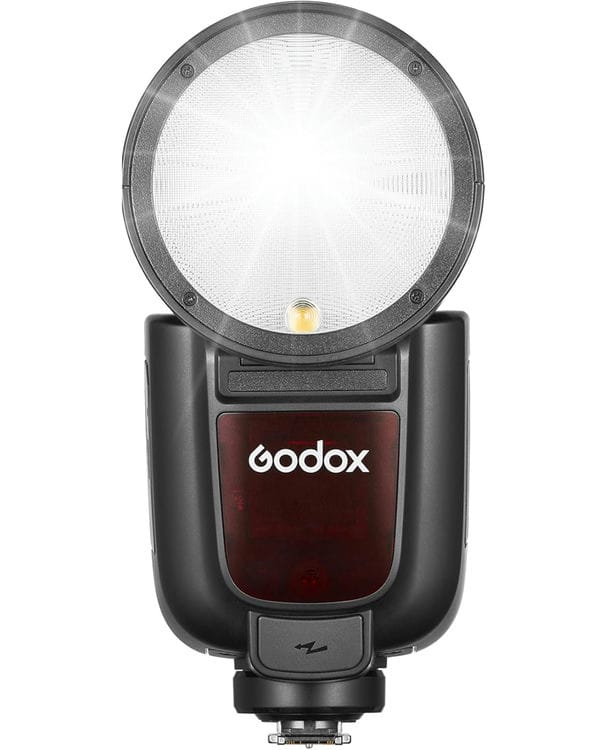 |
|
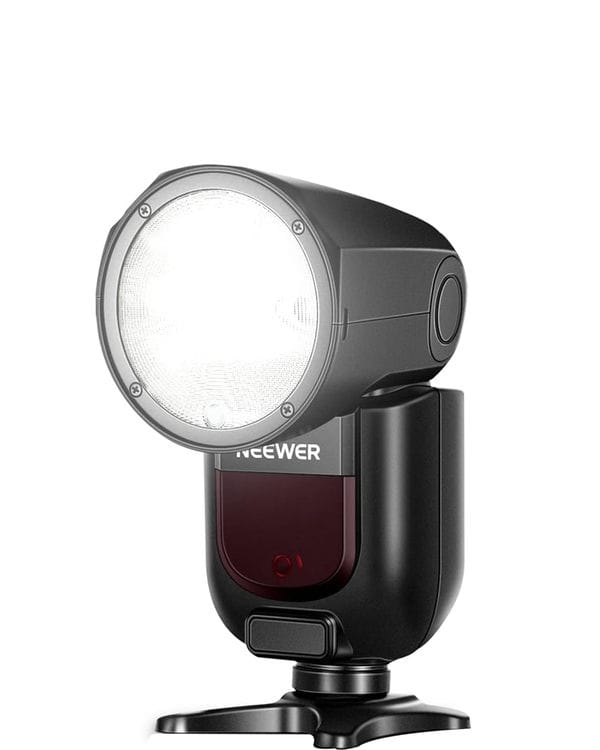 |
|
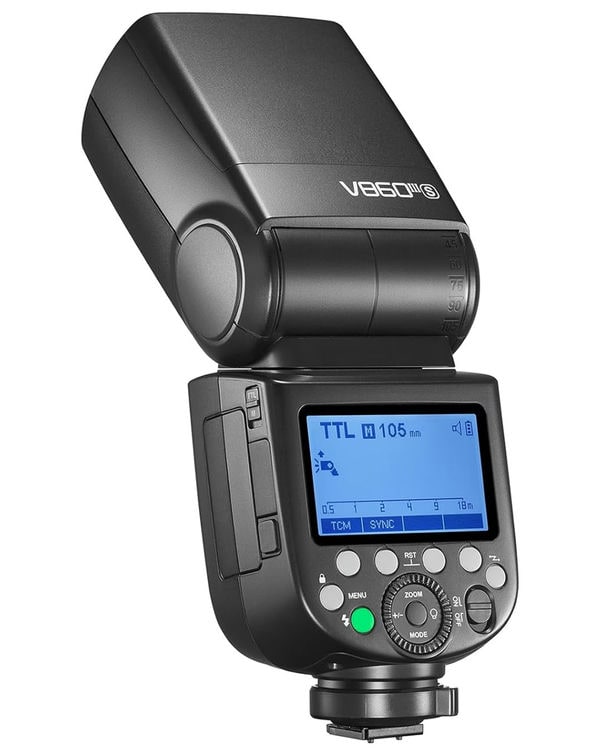 |
|
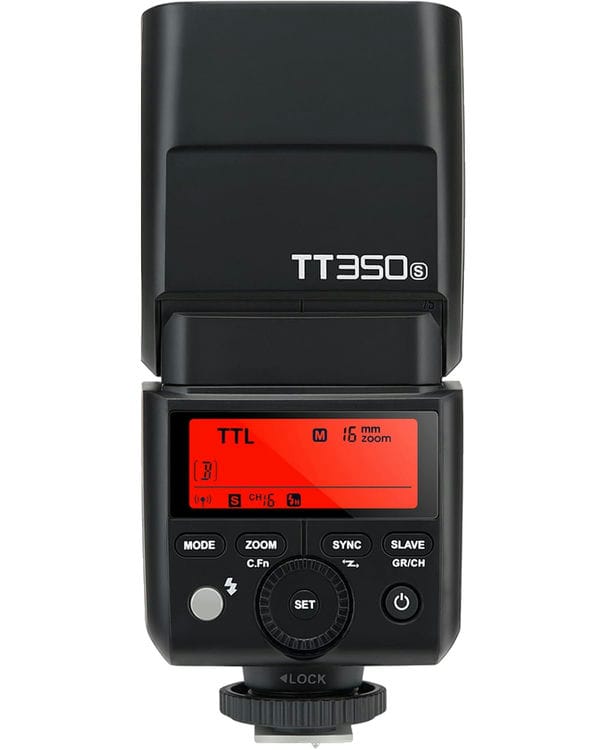 |
|
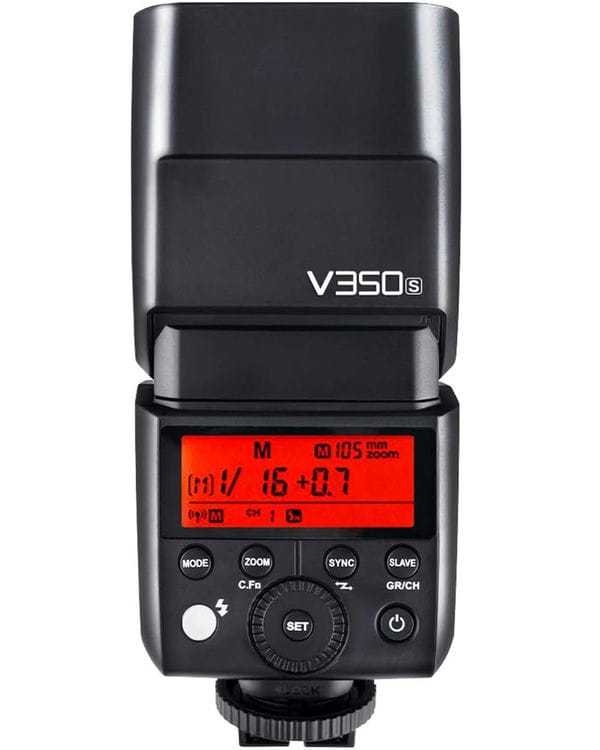 |
|
1. Sony HVL-F60RM2

The Sony HVL-F60RM2 flash is a premium, powerful external flash unit designed for demanding photographers who want consistent, high output and full control over lighting.
With a GN60 (Guide Number 60) rating, this flash delivers strong illumination, while its stable output ensures reliable exposure even in challenging settings.
Whether you’re shooting portraits, weddings, events, or action, its wireless radio control enables flexible lighting setups.
It integrates seamlessly with Sony Alpha cameras via intelligent communication, including features such as face-detection linked flash control and precise white balance adjustment, for natural color rendering.
Rapid continuous flash performance (up to 10 frames per second for as many as 200 flashes) makes it well suited for burst shooting. Its build is rugged, with dimensions and design optimized for comfort, yet capable of mounting AA batteries for convenience.
For users of the Sony A1 II, pairing with the HVL-F60RM2 means tapping into Sony’s flagship flash potential — in power, speed, and intelligent lighting.
- Guide Number: 60 (GN60)
- Flash coverage / zoom range: 20-200 mm (14 mm with wide panel)
- Continuous flash capability: up to 200 flashes in high-speed burst mode
- High-speed burst rate: up to 10 frames per second
- Flash sync speed: 1/400 second
- Weight (without batteries): approx 439 g
- Dimensions: 78.1 × 143.1 × 104.6 mm
- Power source: 4 × AA batteries
High output (GN60) provides strong lighting for both near and distant subjects.
Wide zoom range (20-200 mm, 14 mm with wide panel) adds flexibility.
Excellent performance in burst shooting – supports ~200 flashes at up to 10 fps.
Wireless radio control enables off-camera setup possibilities.
Fast sync speed (1/400 s) for freezing motion.
Durable and well-built for demanding usage.
Compatible with Sony’s intelligent lighting / camera communication, helping for accurate color and exposure.
Hefty weight (~439 g) when handheld or mounted for long durations.
Size is somewhat large, which may be less convenient for travel or tight spaces.
Using AA batteries means frequent battery changes or carrying spares for extended shoots.
Premium price tag compared to simpler flashes or third-party models.
2. Sony HVL-F46RM
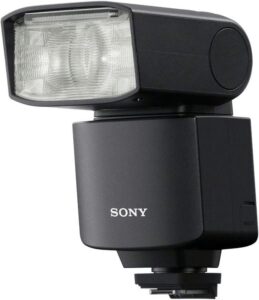
The Sony HVL-F46RM is a premium radio-wireless flash engineered to pair with high-end mirrorless cameras like the Sony A1 II.
It offers a strong Guide Number of 46, delivering reliable lighting without the bulk of bigger units.
This flash excels in burst scenarios, with capability to fire about 60 flashes at 10 frames per second.
It is built tough, featuring dust and moisture resistance, and includes a built-in wide panel to broaden the beam for wider scenes.
With accurate P-TTL metering and stable color performance (around 5,500 K), it adapts well to changing light conditions, making it a versatile tool for portraits, events, and general photography for both amateurs and professionals who seek a balance between portability and power.
- Guide Number (GN): 46 at ISO 100, 105 mm
- Zoom / Coverage: 24-105 mm, plus built-in wide-angle adapter panel (~15 mm)
- Continuous flash burst: up to 60 flashes at 10 fps
- Color temperature: approx 5,500 K
- Dimensions: approx 69.4 × 114.7 × 88.9 mm
- Weight (without batteries): approx 308 g
- Power source: 4 × AA batteries
- Features: P-TTL control; wireless radio communication; dust and moisture resistance; stable output
- Strong power output (GN46) that’s sufficient for many indoor and outdoor scenarios without overkill.
- Excellent burst performance (≈ 60 flashes @ 10 fps) lets you capture fast action.
- Compact and lighter than many high-end flashes, making it more comfortable for handheld or off-camera use.
- Wide zoom-coverage including wide-angle panel helps with flexibility in framing and lighting.
- Reliable P-TTL and wireless radio control give good integration with Sony A-series cameras, improving ease of use and consistency.
- Solid weather resistance (dust/moisture) increases durability for outdoor shoots.
- Stable color output and consistent exposure across bursts, reducing unwanted variation.
- Requiring AA batteries means extra weight, potential downtime swapping batteries, and carrying spares.
- At full power, recycle times are slower—may lag behind when pushing it hard.
- Still heavier and larger compared to very compact flashes, so portability is good but not the smallest.
- Though powerful for its size, it doesn’t match the peak output of flagship flashes for very large venues or extreme lighting needs.
3. Godox V1 Pro–Sony

The Godox V1 Pro – Sony flash brings together high performance and flexible design, making it a strong lighting partner for the Sony A1 II.
With a round-flash head, it produces softer, more even light, reducing hard shadows and yielding more natural results with bounce lighting.
It supports TTL and manual modes, plus high-speed sync up to 1/8000s, giving freedom over exposure even in bright conditions.
Powered by a lithium-ion battery, it delivers many full-power flashes and has fast recycle times, helping to keep pace with fast-moving subjects.
It also offers useful extras like a detachable SUB flash for fill-light, adjustable LED modeling lamp, and wireless control over 2.4 GHz. For photographers who do weddings, events, portraits or hybrid photo/video, the V1 Pro gives a versatile lighting tool that balances power, speed, and quality.
- Power output: 76Ws
- Full-power flashes: about 500
- Recycle time: approx 1.3 seconds
- Flash sync / HSS: up to 1/8000 s
- Wireless control: 2.4 GHz system
- Battery type: Lithium-ion, capacity ~ 2,980 mAh
- Additional lighting: LED modeling lamp (10-level)
- Built-in detachable SUB flash (fill-light)
- Round head produces softer, more even light which is great for portraits and bounce work.
- Fast recycle time (≈ 1.3 s) helps with quicker shooting after full power flashes.
- Large capacity battery giving ~500 full-power flashes, reducing interruptions.
- High-speed sync up to 1/8000s allows creative control over ambient light in bright environments.
- Detachable SUB flash offers extra flexibility for fill-light or creative lighting setups.
- LED modeling lamp (with multiple levels) helps preview lighting effects and improve workflow.
- Wireless 2.4 GHz control makes off-camera or multi-flash setups easier.
- Battery size and weight, due to the lithium battery, can make the flash bulkier / heavier compared to simpler AA-powered flashes.
- At full power, recycling is decent but still slower than lower power settings, so heavy use may need patience or backup batteries.
- More moving/attachments (SUB flash, modeling lamp, etc.) mean more things that can need maintenance or that could fail.
- As a feature-rich flash, price may be premium, making it less accessible for casual or entry-level users.
4. Neewer Z1-S Flash
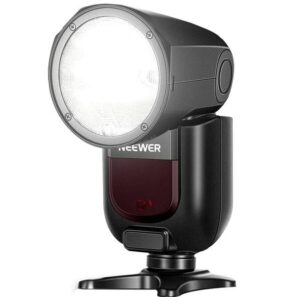
The Neewer Z1-S Flash is a modern, powerful round-head speedlight designed to elevate lighting for mirrorless cameras like the Sony A1 II.
Thanks to its 76Ws power output and high-speed sync up to 1/8000s, it gives photographers the ability to balance strong flash output with bright ambient light, ideal for both indoor and outdoor shoots.
Equipped with a built-in 2600mAh lithium battery, it delivers up to ~480 full-power flashes with recycling times around 1.5 seconds—helpful when shooting events or dynamic scenes.
It also features a 10-level LED modeling lamp, offering preview lighting and improving workflow when setting up shots. Its 2.4GHz wireless system adds flexibility for off-camera setups.
The round flash head and dome diffuser options help produce softer light and more natural falloff, making it well suited for portraits or bounce lighting.
- Power: 76Ws
- Full-power flashes per charge: approx 480
- Recycle time: about 1.5 seconds
- High-speed sync (HSS): up to 1/8000s
- Battery: built-in li-ion battery, 2600mAh
- LED modeling lamp: 10 levels brightness control
- Wireless: 2.4GHz communication system
- Diffuser / dome softening options for the round head
- Strong power output (76Ws) gives headroom for lighting in larger spaces or when using modifiers.
- Generous battery capacity (≈ 2600mAh) supports a high number of full-power flashes (~480), reducing downtime.
- Fast recycling (~1.5 seconds) allows quicker successive shots.
- High-speed sync up to 1/8000s enables creative control in bright ambient light.
- LED modeling lamp with multiple levels helps with previewing lighting effects and video or mixed work.
- 2.4GHz wireless allows flexible off-camera setups or multi-flash arrangements.
- Soft round head + diffuser options produce more forgiving, natural light, especially good for portraits or bounce lighting.
- As with many powerful flashes, weight and size may be higher; carrying it for long shoots may fatigue.
- Though recycle is good at 1.5 seconds, at full-power and heavy output it may still lag compared to smaller flashes with lower power.
- Battery is internal—if something goes wrong with battery or its charger, replacements or repairs may be more involved.
- Though feature-rich, it may not match build quality or weather sealing of premium brand flashes, possibly less durable in harsh conditions.
5. Godox V860III-S
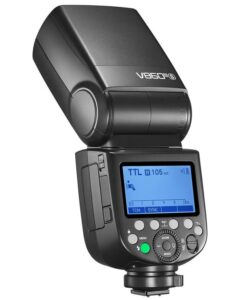
The Godox V860III-S Flash is a high-performance speedlite designed to elevate lighting for Sony mirrorless cameras such as the A1 II. Featuring 76Ws output and a powerful 7.2V / 2600mAh lithium-ion battery.
it delivers approximately 480 full-power flashes with a recycle time around 1.5 seconds.
High-speed sync up to 1/8000 second makes it suitable for shooting in bright light or fast action, while the built-in 2.4GHz wireless X-system enables flexible off-camera setups.
It includes a 10-level LED modeling lamp to preview lighting effects and assist in mixed-light or video scenarios.
With zoom coverage from 20 to 200mm, this flash gives you strong range and versatility.
All these features make the V860III-S a well-rounded flash choice for both event and creative photography with the A1 II.
- Output power: 76Ws
- Battery: 7.2V / 2600mAh lithium-ion
- Full-power flashes per charge: approx 480
- Recycle time: about 1.5 seconds
- High-speed sync (HSS): up to 1/8000 second
- Zoom / coverage: 20-200mm
- Color temperature: approx 5300K ± 200K
- Flash duration: approx 1/300 to 1/20000 seconds
- Wireless functions: built-in 2.4GHz wireless X system; works as transmitter or receiver; multiple channels & ID settings
- High output with 76Ws gives strong illumination and reach.
- Large battery capacity lets you shoot many full-power bursts without frequent recharging.
- Fast recycle time (~1.5 seconds) aids in continuous or burst shooting.
- HSS up to 1/8000s allows creative control even in bright conditions.
- LED modeling lamp helps preview lighting setup and aids in mixed photo/video work.
- Versatile
- The unit is relatively large and heavier than simpler flashes, which may make handheld long sessions more tiring.
- While performance is good, at full power the battery drains faster, and recycle time may slow under heavy use.
- More features means more controls—can be a steeper learning curve for beginners.
- May lack advanced weather sealing compared to some premium Sony-branded flashes, so careful use in harsh conditions is recommended.
6. Godox TT350S
The Godox TT350S Flash is a compact and versatile speedlite made for Sony mirrorless cameras like the A1 II.
Despite its small size, it offers strong features: TTL auto flash, high-speed sync up to 1/8000 second, and wireless 2.4GHz support.
The guide number of 36 (at ISO 100, 105mm) gives enough power for many portraits or indoor scenes.
With zoom coverage from 24-105mm (plus a wide-angle panel), and support for modes such as TTL, Manual, S1/S2, this flash adapts well to varied lighting conditions.
Because it’s lightweight, it’s easier to handle on long shoots or when carrying gear.
For those shooting events, travel, portraits or hybrid photo/video, the TT350S offers a useful balance of portability, performance, and flexibility with the Sony A1 II.
- Guide Number: 36 at ISO 100, 105 mm
- Zoom / coverage: 24-105 mm (with wide-angle panel support)
- Flash sync / high-speed sync (HSS): up to 1/8000 s
- Power & exposure modes: TTL, Manual, S1 / S2 slave modes
- Wireless: built-in 2.4GHz wireless X system
- LCD panel + button/dial controls for settings
- Power source: 2 × AA batteries
- Tilt / swivel head: rotates / tilts for bounce and indirect lighting
- Master/slave functionality (can be master or slave in multi-flash setups)
- Compact and lightweight, makes it easy to carry for travel or long shooting sessions.
- High-speed sync (up to 1/8000 s) lets you work in bright ambient light and use wide apertures.
- Wireless radio (2.4GHz) support enables off-camera setups and compatibility with other flashes & triggers in the Godox system.
- Multiple modes (TTL, Manual, S1/S2) give flexibility in exposure control depending on how much manual vs auto you want.
- Zoom range covers versatile focal lengths, especially with the wide-angle panel for broader coverage.
- Master/slave capability allows it to act as a controller or be controlled in multi-flash setups.
- User-friendly controls (LCD + buttons/dials) make changing settings easier in varied lighting conditions.
- Because it runs on AA batteries, full-power bursts can drain batteries quickly; you may need spares.
- Output is more modest (GN36) compared to larger or flagship flashes, so for large venues or very long distances you may need more power.
- Recycle times at full power or during rapid successive shooting are slower than premium flash units.
- Lacks premium features such as a built-in lithium-battery pack, very fast recycling, or extra rugged/sealed weather protection found in high-end flashes.
7. Godox V350S

The Godox V350S is a smart, compact speedlight designed for Sony mirrorless cameras like the A1 II.
It combines a powerful rechargeable lithium battery with full TTL functionality and high-speed sync up to 1/8000 s, allowing photographers to shoot in bright conditions or freeze action without compromise.
With a Guide Number of 36 (at 105 mm, ISO 100), it gives enough output for portraits, indoor shoots, and fill light. The V350S features a fast recycle time (from 0.1 s to 1.7 s depending on power level) and can deliver over 500 full-power flashes per charge.
It supports wireless 2.4 GHz triggering, multiple flash modes (TTL, manual, etc.), and has zoom range covering approx. 24-105 mm.
All these make it a strong option for creatives who want solid performance in a lighter, more travel-friendly flash for the A1 II.
- Guide Number: 36 (ISO 100, 105 mm)
- Zoom / coverage: 24-105 mm
- High-speed sync: up to 1/8000 s
- Recycle time: approx 0.1 s – 1.7 s depending on power
- Battery: built-in lithium-ion, approx 2000 mAh
- Full-power flashes per charge: over 500
- Wireless: built-in 2.4 GHz wireless system
- Flash modes: TTL, Manual, Multi; support for flash exposure compensation, front/rear/curtain sync
- Rechargeable battery with strong capacity reduces need for carrying many AA batteries.
- High-speed sync up to 1/8000 s allows shooting in bright light or with wide apertures without overexposure.
- Quick recycle (as low as 0.1 s at lower power) means faster shooting when bursts are needed.
- Wireless 2.4 GHz control gives flexibility for off-camera setups or using it in a multi-flash system.
- Versatile zoom range (24-105 mm) covers common focal lengths for portraits, events, etc.
- Over 500 full-power flashes per charge offer good endurance for event or wedding or long shoots.
- Multiple modes (TTL, manual, etc.) and flash exposure compensation make it adaptable to different lighting styles and creative needs.
- Guide Number 36 is modest compared to higher-end flashes; may struggle in very large or far-distance lighting scenarios.
- At full power, recycle times approach upper limit of ~1.7 s, which slows down rapid shooting.
- As it uses a built-in battery, if the battery degrades or fails, replacement or repair may be more involved than swapping external batteries.
- Smaller size and lighter build often come with trade-offs: less durability or fewer advanced features (weather sealing, extremely rugged housing) compared to premium Sony flashes.
ABOUT CAMERA
The Sony A1 II is Sony’s flagship full-frame mirrorless camera, engineered for professionals who demand top-tier performance in stills, speed, video, and autofocus.
It retains the 50.1-megapixel stacked CMOS sensor of its predecessor but adds notable upgrades in processing, subject detection, stabilization, and usability.
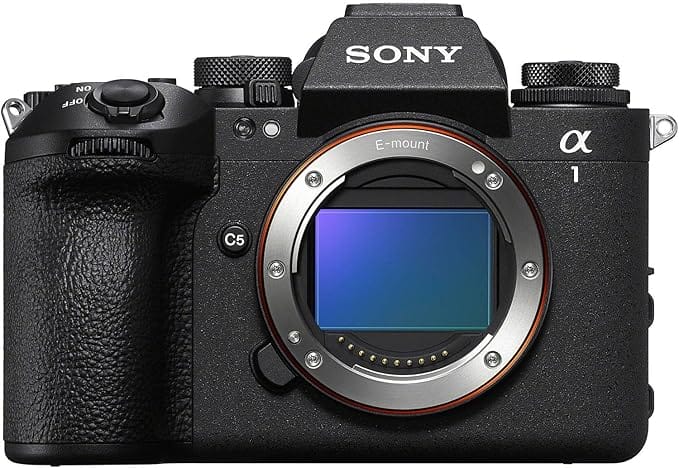
It’s built for action, wildlife, sports, weddings—any scenario where you need high resolution and rapid responsiveness.
One of its standout features is the 30 frames per second burst shooting (using the electronic shutter) with full autofocus and auto-exposure tracking, which allows capturing decisive moments without blur.
Sony has significantly advanced its subject detection algorithms: the A1 II can recognize and track humans, animals, birds, insects, even vehicles, with higher precision and improved real-time recognition.
The upgraded in-body image stabilization (IBIS) delivers up to about 8.5 stops of shake correction (especially strong in the center), which helps in low light or with slower shutter speeds when handheld.
Video shooters will appreciate that the A1 II supports 8K video at 30 fps (oversampled), high bit-depth color profiles (10-bit), and strong 4K options up to 120 fps, making it suitable for both cinematic work and high frame-rate slow motion.
The viewfinder and LCD have also been enhanced: a high resolution (~9.44 million dot) OLED electronic viewfinder with fast refresh and a 4-axis vari-angle LCD for flexible shooting angles.
Physically, the A1 II is rugged, weather-sealed, and retains an NP-FZ100 battery.
Its build includes dual card slots (CFexpress Type A + UHS-II SD), fast connectivity (USB-C, WiFi), and practical ergonomic improvements like better grip and interface tweaks.
For photographers who want pro-level image quality, ultra-fast autofocus, and strong video capability in one body, the A1 II is among the most capable mirrorless options available.
Key Features to Look at When Buying the Best Flash for Sony A1 II
- Guide Number (GN) / Output Power:
The Guide Number tells you how powerful the flash is — how far it can light a subject at a given ISO and aperture. For the A1 II, which is capable of high frame-rates and low noise, a higher GN gives you flexibility: you can shoot farther, or use smaller apertures (for deeper depth of field) without compromising exposure. - High-Speed Sync (HSS):
The Sony A1 II has fast shutter capabilities, and to use flash at fast shutter speeds (beyond its standard sync speed), you’ll need HSS. This is especially useful outdoors in bright light or when you want to use wide apertures for a shallow depth of field while retaining ambient light nicely. - Recycle Time and Flash Burst Ability:
Since the A1 II can shoot very fast (very high fps in continuous mode), you’ll want a flash that can keep up. Fast recycle time (how quickly the flash is ready after firing) and ability to deliver a number of full-power flashes in quick succession (or sustain bursts) are critical so you don’t miss key moments. - Native Compatibility & TTL Functionality:
The flash should support Sony’s TTL (Through-The-Lens) metering or equivalent so the camera can automatically calculate correct flash power. Also having native compatibility (Multi Interface Shoe, proper contacts, proper firmware) ensures features like TTL, wireless control, and exposure compensation all work smoothly with the A1 II. - Wireless Control & Ecosystem / Flash Triggering Options:
If you want to use off-camera flash or multi-flash setups, built-in wireless radio control is hugely beneficial (rather than optical slave only). Check for how many channels, groups, reliability of signal, range, and whether the flash can act as master or slave. Also consider whether third-party triggers are reliably supported. - Zoom Head / Coverage & Bounce/Tilt/Rotate Mechanics:
The ability of the flash head to zoom (adjust its beam) to match focal lengths (e.g. wide angle to telephoto) is helpful. Similarly, tilt/swivel/rotate functionality lets you bounce light off ceilings or walls, which gives softer, more pleasing light rather than harsh direct flash. - Power Source & Battery Type:
Some flashes use AA batteries, others have built-in lithium-ion batteries. Li-ion usually offer more flashes per charge, faster recycle, but may be heavier or more costly. Consider battery life, ease of charging or replacing, availability of spare battery units, and possible weight with battery. - Durability & Build Quality:
If you shoot outdoors or in demanding environments (weddings, location work, etc.), weather sealing, robust build, protectors for flash foot, etc., become important. Also, good heat dissipation helps if you use the flash in rapid or burst modes so it doesn’t overheat. - Flash Modes & Control Features;
Features like manual mode, TTL, multi/stroboscopic flash, front-curtain/rear-curtain sync, exposure compensation, modeling lamp or LED assist light, etc., all add flexibility. These let you adapt to different lighting conditions, creative styles, and fast-changing scenes. - Size / Weight & Portability:
Because mirrorless systems like the Sony A1 II are often used for travel, events, or handheld work, flash size and weight matter. A compact flash that still delivers adequate power can be more useful in many real-world shooting situations than a heavier, higher-powered flash that’s cumbersome.
FAQs
Conclusion
The Sony A1 II stands as one of the most advanced all-round mirrorless cameras available, combining ultra-high resolution, blazing speed, and intelligent autofocus in a single body.
With its 50.1-megapixel stacked sensor, blackout-free 30 fps continuous shooting, AI-powered subject recognition, and up to 8.5 stops of in-body image stabilization.
it delivers top-tier performance for professionals in wildlife, sports, weddings, or studio work.
Its video specs are also impressive, offering 8K at 30 fps, strong 4K options, and high bitrate profiles for creative freedom.
The camera’s refined ergonomics, improved handling, and articulated display add to its usability, especially during long shoots or hybrid photo-video workflows.
However, such premium capability comes at a price.
The A1 II is expensive, large compared to lighter mirrorless bodies, and some features are demanding on storage, batteries, or post-processing workflows.
It’s overkill for basic use or travel without ambition. But for those who demand elite image quality, speed, and versatility in both stills and video, the Sony A1 II is a standout choice that delivers exceptional value in its class.
